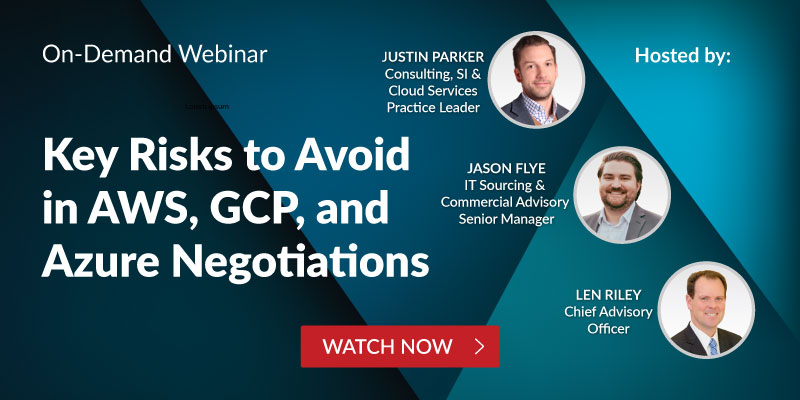- Jason Flye
- Reading Time: 5 minutes

An Overview of GCP, AWS, and Azure’s Credit and Incentive Offerings
Customers today are being offered increased levels of hyperscaler credits and incentives to drive them to select that certain hyperscaler’s platform. When paired with a competitive sourcing event, customers can drive optimized commitment discounts as well as enhanced credits and incentives to help lower their Total Cost of Ownership (TCO) over the long-term.
In this blog post, we will dive deeper into the types of credits and incentives that Google Cloud Platform (GCP), Amazon Web Services (AWS), and Microsoft Azure are putting on the table and how those should be evaluated as part of a holistic hyperscaler negotiation.
Hyperscaler Credits and Incentives
GCP, Azure and AWS are becoming increasingly creative in how they approach incentives to drive adoption of their cloud services platform. These hyperscalers will position one or more of these major areas of credits and incentives, each with their own strings attached:
- Cloud Consumption Credits (applied against compute and storage consumption costs)
- Implementation / Migration Credits (applied against chosen SI)
- Other Incentives (consulting/training credits, pro services discounts, support percentage reduction, Hybrid Cloud Use Benefits)
-
Cloud Consumption Credits
The first element that hyperscalers will generally position with customers considering a specific program/effort is cloud consumption credits. These credits are a one-time investment on the part of the hyperscaler to drive down compute and cloud storage consumption costs during the current term. These credits are often provided to help offset parallel run costs, limiting the cost incurred by a customer when they need to run the same platform in two environments during a migration.
Given that these credits are designed to offset a short term issue, these credits are generally non-renewable and will not be offered again upon conclusion of the term. If a customer is willing to entertain growth or additional spend after the conclusion of the initial term, they may be able to see some consumption credits offered in a subsequent term. But it is unlikely to be offered again without that growth.
In addition, the size of these cloud consumption credits is proportional to the amount of spend the customer is willing to commit to during the length of the term as well as the size of the parallel run period. While it may be tempting to seek to maximize these credits by committing to more spend, please note that these commitments are fixed and may end up trapping customers into utilization goals they may never achieve. Ensure any commitments made are aligned to your enterprise-wide cloud migration strategy and factor in the use of Reserved Instancing over the long-term.
-
Implementation / Migration Credits
If a customer’s move to the cloud requires significant time and investment from a system integrator, then you will often see hyperscalers offer up implementation/migration credits. Like cloud consumption credits, these are a one-time investment made by the hyperscaler to lower migration costs to their platform.
Based on the relationship between the hyperscaler and the system integrator, these credits may be offered as a direct offset to the implementation costs (i.e. hyperscaler pays the system integrator directly), or it may be offered as additional cloud consumption credits (i.e. hyperscaler provides additional cloud credits to the customer intended to offset the impact of the implementation).
These implementation/migration credits are often limited to specific implementation partners whom the hyperscaler has an established partnership with. This is intentional – hyperscalers have a symbiotic relationship with these SIs, each driving business to one another and ensuring a mutually beneficial outcome.
Customers will often see, especially in a competitive sourcing environment, that hyperscalers will “team up” with specific SIs, or SIs will provide a joint proposal with a specific hyperscaler. It is possible to break this link, but it is important that any time implementation credits are put forward that a customer understands the SI-specific limitations involved in receiving that credit.
Similar to the cloud consumption credits, these implementation credits are also proportional to the size of the implementation/migration that will occur. Because of this, it is critical that the hyperscaler receive a level of depth/understanding surrounding the size of implementation as part of the solicitation process. This will not only allow for the positioning of an appropriate implementation credit, but also prevent gaps and limit risk during the implementation itself.
-
Other Hyperscaler Incentives
While cloud consumption credits and implementation/migration credits are the most straightforward ways for hyperscalers to impact TCO during a cloud migration, hyperscalers are coming up with additional, creative ways in an attempt to tip the balance in their favor during an evaluation process.
The below are a few different additional means that hyperscalers can use to add more value. This list is by no means exhaustive, as hyperscalers will leverage the breadth of their knowledge and existing relationship to add sweeteners during the negotiation process:
- Consulting/Training Credits – Beyond the scope of the implementation at hand, hyperscalers may offer consulting or training credits to help support other project-related work within the customer’s organization. These credits are often a means for the hyperscaler to open the door to additional avenues of work, as these consulting needs often will involve additional cloud utilization.
- Professional Services Discounts – In addition to credits, Hyperscalers may also offer discounts against future Professional Services during the term. These professional services discounts are more common on larger scale spend commitments, with a clear business need for services direct with the hyperscaler.
- Support Percentage Reduction – When pressed in a competitive evaluation effort, hyperscalers may offer to reduce the hyperscaler support costs via a reduction in the support percentage. Microsoft establishes this percentage in its Unified Support Agreement, which fixes the calculation of support by a percentage of spend with Microsoft. Customers can see Microsoft’s offer to reduce this Unified Support percentage, as an additional value-add within the scope of the negotiation. Google may offer a similar incentive, allowing for the reduction of the support percentage in its Premium Support agreement.
- Hybrid Use Benefits (Microsoft Only) – Microsoft is uniquely positioned in the hyperscaler market, given its widescale productivity, database and server platform technology. Microsoft leverages this position by offering the Hybrid Use program. This program allows companies with existing on-premise Windows Server and SQL licenses with active Software Assurance to bring these licenses to Azure. This allows for customers to avoid repurchasing these licenses and, instead, shift the usage directly into Azure.
SQL Server and Windows Server Standard may be used on-premise or in Azure, but not concurrently. Microsoft offers a window of 180 days for concurrent use to allow for migration of server workloads from an on-premise datacenter to Azure. Windows Server Datacenter licenses can be used concurrently in both on-premise and Azure.
Customer Takeaway for Hyperscaler Credits and Incentives
When evaluating a potential hyperscaler for your enterprise, it is critical to understand the commitment discounts as well as any credits and incentives that the hyperscaler may position. You should also be sure to review how the key commercial terms are different between each provider.
Understanding these components, as well as how they interact and affect each other, is necessary in your hyperscaler evaluation. It ensures that you are receiving the right balance of discounts, credits and incentives that bring down short-term and long-term total cost and protect your company from undue and unnecessary financial risk.
Customers who want to strategically bring down their short and long-term TCO would benefit from engaging a third-party advisor who can help them develop a holistic strategy. Reach out today to learn how our hyperscaler experts can help with your unique business case.


